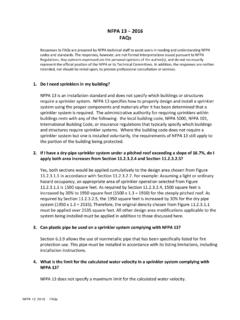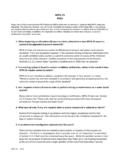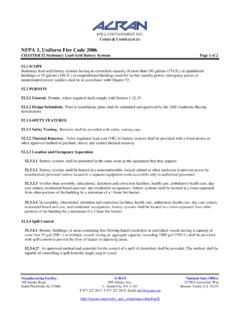Transcription of NFPA 72 - Fire Prevention Association of Nevada
1 nfpa 72 False Alarm. Activation or reporting of an alarm for which no such alarm condition, fire or emergency actually exists. Additionally, False Alarm is the willful and knowing initiating or transmission of a signal, message or other notification of an event of fire when no such danger exists. Dedicated Function Fire Alarm System. A protected premises fire alarm system installed specifically to perform fire safety function(s) where a building fire alarm system is not required. Such systems include, but are not limited to sprinkler monitoring systems and elevator recall systems. (SIG-PRO) Dedicated Branch Circuit. A dedicated branch circuit of one of the following: shall supply primary power from a commercial light and power source. (1) Commercial light and power. Exceptions: (1) When approved by the AHJ, an engine-driven generator or equivalent in accordance with , where a person specifically trained in its operation is on duty at all times may be used for a specified period of time.
2 (2) When approved by the AHJ, an engine-driven generator or equivalent arranged for cogeneration with commercial light and power in accordance with , where a person specifically trained in its operation is on duty at all times may be used. * Protection of Fire Alarm System. In areas that are not continuously occupied, automatic smoke detection shall be provided at the location of each fire alarm control unit(s), notification appliance circuit power extenders, and supervising station transmitting equipment to provide notification of fire at that location. Exception No. 1: Where ambient conditions prohibit installation of automatic smoke detection, automatic heat detection shall be permitted. Exception No. 2: Dedicated function fire alarm systems shall not have smoke detectors installed above the dedicated function fire alarm control unit. Alarm Annunciation. The location of an operated initiating device shall be displayed by an alphanumeric display at the fire alarm control unit.
3 Unless otherwise approved, the alphanumeric display shall show the device type, floor level (if applicable), device address (if applicable), and a descriptive location for the operated device(s). The visible annunciation of the location of operated initiating devices shall not be canceled by the means used to deactivate alarm notification appliances. Alarm annunciators shall comply with all of the following: 1. If a building has a main entrance/foyer, a remote annunciator shall be provided inside the building at the main entrance/foyer. Exception: When the fire alarm control unit is located inside the building at the main entrance/foyer, a remote annunciator is not required at the main entrance/foyer. 2. If a building has a fire riser room with an exterior door, a remote annunciator shall be provided within the fire riser room. Exception: When the fire alarm control unit is located within the fire riser room, a remote annunciator is not required within the fire riser room.
4 3. The location of an operated initiating device shall be displayed by alphanumeric display at the annunciator. 4. The alphanumeric display shall state the device type, the floor level (if applicable), the device address and a descriptive location for the operated device(s). 5. The visible annunciation of the location of operated initiating devices shall not be canceled by the means used to deactivate alarm notification appliances. Where required by other governing laws, codes or standards, the location of and operated initiating device shall be annunciated by visible means. Visible annunciation of the location of an operated initiating device shall be by an indicator lamp, alphanumeric display, printout or other approved means. The visible annunciation of the location of operated initiating devices shall not be canceled by the means used to deactivate alarm notification appliances. * The installation of all pathway wiring, cable and equipment shall be in accordance with nfpa 70, National Electric Code and the applicable requirements of through In all occupancies, other than residential two stories or less, all wiring, including optical fiber cables, shall be in enclosed metallic conduit or shall be MI, MC, or AC cable.
5 (SIG-FUN) Total (Complete) Coverage. Where required by laws, codes, or standards, and unless otherwise modified by through , total coverage shall include all rooms, halls, storage areas and basements. Attics, lofts, spaces above suspended ceilings, and other subdivisions and accessible spaces; and the inside of all closets, elevator shafts, enclosed stairways, dumbwaiter shafts, and chutes shall also have detectors if required by the authority having jurisdiction or to satisfy performance design criteria. Inaccessible areas may not be required to be protected by detectors. When area detectors are installed instead of duct smoke detectors to comply with the Uniform Mechanical Code total coverage is defined as the area served by the air-moving equipment. * The minimum spacing of heat detectors shall not be required to be less than times the height of the ceiling. If the intent is to protect against a specific hazard, and the detectors are not otherwise required by this code or other applicable codes, the detector(s) shall be permitted to be installed closer to the hazard in a position where the detector can intercept the smoke.
6 Activation of the initiating device shall occur within 90 60 seconds of waterflow at the alarm-initiating device when flow occurs that is equal or greater than that from a single sprinkler of the smallest orifice size installed in the system. Voltage drop calculations shall be performed using one of the following methods: (1) The lump sum calculation method, which shall be calculated as follows: (a) Calculate the voltage drop using one of these formulas: i. VD = I * ((R * 2 * L)/1,000) OR ii. VD = (2 * K * I * L)/CM. (b) Subtract this calculated voltage drop from volts (VS) in order to get the voltage value at the end of the circuit (VS VD = VEOL). The value for VEOL shall be a minimum of 16 volts (the minimum operating voltage required for a listed 24 vdc notification device). (2) The point-to point method, which requires a math-intensive approach where the voltage drop between each notification appliance is reiterated. This method is best done by utilizing a spreadsheet program.
7 The calculated voltage at the last device on the circuit shall be a minimum of 16 volts (the minimum operating voltage required for a listed 24 vdc notification device). Where: VD = Voltage Drop VS = Starting voltage ( , or the end of useful battery life) VEOL = Voltage at the end-of-line resistor I =Total load of the circuit in amperes utilizing current draws for each notification appliance @ 16vdc (the UL maximum draws at the minimum listed voltage). R = Resistance in ohms per 1,000 feet, with respect to conductor K = ohms (the constant representing the mil-foot resistance of copper wire) L = length of circuit in feet (distance from panel to end-of-line resistor for class B circuits) CM = circular mill of wire, with respect to conductor. VSOURCE = voltage calculated at the previous device Wire R CM No 18 1,620 No 16 2,580 No 14 4,110 No 12 6,530 Audible notification appliances for alert and evacuation signal tones shall meet the requirements of (Public Mode Audible Requirements), (Private Mode Audible Requirements), (Sleeping Area Requirements), or (Narrow Band Tone Signaling for Exceeding Masked Thresholds), as applicable.
8 Voice messages shall not be required to meet the audibility requirements of (Public Mode Audible Requirements), (Private Mode Audible Requirements), (Sleeping Area Requirements), or (Narrow Band Tone Signaling for Exceeding Masked Thresholds), but and shall meet the intelligibility requirements of where voice intelligibility is required. * The minimum sound level for alarm signals shall be 80 decibels, or a minimum of 15 decibels above ambient, whichever is greater, in all occupied areas for all occupancies. One of the two methods below shall be utilized to ensure that a minimum of 80 decibels, or a minimum of 15 decibels above ambient, whichever is greater, will be achieved: (1) Audible notification devices shall be installed in each occupied area, including but not limited to spaces such as bathrooms, walk-in closets, storage rooms, and walk-in coolers/freezers. (2) In lieu of providing audible notification devices within certain spaces, calculations may be performed in order to prove that the alarm signals from the proposed adjacent audible devices will achieve a minimum of 80 decibels, or a minimum of 15 decibels above ambient, whichever is greater, inside and throughout that space, where doors or other barriers between the space and the adjacent audibility device(s) are closed.
9 In terms of this context, occupied areas are spaces capable of having occupancy and of such size to reasonably allow a person inside the space. One- and Two-Family Dwellings are not required to meet the requirements of Section Critical care areas of health care facilities shall be allowed to have visible notification appliances in lieu of audible notification appliances when approved by the authority having jurisdiction. Where occupants are incapable of evacuating themselves because of age, physical or mental disabilities, or physical restraint, the private mode as described in nfpa 72, National Fire Alarm Code, shall be permitted to be used when allowed by the AHJ. Only the attendants and other personnel required to evacuate occupants from a zone, area, floor, or building shall be required to be notified when allowed by the AHJ. The notification shall include means to readily identify the zone, area, floor, or building in need of evacuation.
10 Visible notification appliances shall be installed in accordance with Table (a) or Table (b) using one of the following: (1) A single visible notification appliance (2) Two visible notification appliances located on opposite walls (3)*Two groups of visible notification appliances, where visual appliances of each group are synchronized, in the same room or adjacent space within the field of view. This shall include synchronization of strobes operated by separate systems (4) More than two visible notification appliances or groups of synchronized appliances in the same room or adjacent space within the field of view that flash in synchronization Exception: Where a portion of a room or space is remodeled and new or existing strobes are within the area of the remodel, such strobes are required to synchronize with each other, but are not required to synchronize with existing strobes in the field of view if the existing strobes are outside of the remodel area and were installed prior to the adoption of the 1996, or later, edition of nfpa 72.





